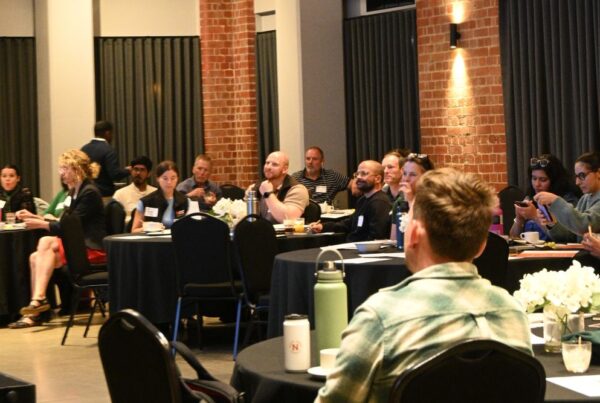
In the bustling world of corporate events, the significance of a well-thought-out seating arrangement cannot be overstated. At the heart of any successful gathering lies the strategic placement of attendees, designed to foster effective communication and networking. By carefully arranging seating, organizers can create an environment that encourages interaction, promotes collaboration, and instills a sense of community and engagement among guests. Furthermore, seating plans can spotlight key individuals such as speakers, sponsors, or VIPs, enhancing their visibility and recognition. A thoughtfully designed seating arrangement enhances the attendee experience, creating a positive and productive atmosphere conducive to networking and collaboration. Here is United Co.‘s guide to the best seating arrangements for your next event.
What is the main purpose of a seating arrangement at a corporate event?
The main purpose of a seating arrangement at a corporate event is to facilitate effective communication and networking among attendees. How to choose the best seating arrangement for your event depends on several factors. By strategically placing guests at tables or in designated areas, organizers can encourage interaction between individuals and groups, promote collaboration, and create a sense of community and engagement.
The seating arrangement may also be used to highlight important individuals or groups, such as speakers, sponsors, or VIPs, and to create a visually appealing and well-organized event space. The overall aim of implementing a seating arrangement at a corporate event is to enhance the entire experience for attendees and create a positive and productive atmosphere for networking and collaboration.
What is an example of a corporate seating arrangement?
An example of a corporate seating arrangement could be a U-shaped layout with tables arranged in the shape of a “U” with the open end facing the stage or presentation area. This type of arrangement is most often used for events such as conferences, where attendees need to be able to see and hear the speakers or presenters, and also allows for interaction and discussion among participants.
Another example could be a banquet-style seating arrangement, with round tables set up throughout the event space, often used for formal dinners or award ceremonies. In this setup, attendees can network and socialize while enjoying a meal or watching a presentation on a stage or podium.
Many different seating arrangements can be used for corporate events, depending on the specific goals and needs of the event organizers.
Types of seating arrangements at corporate events
Several types of seating arrangements can be used at corporate events, depending on the specific goals and objectives of the event.
Theater-Style Seating
This is a traditional seating arrangement where chairs are set up in rows facing the front of the room where the stage or presentation area is located. This is often used for conferences, seminars, or presentations.

Classroom-Style Seating
This is similar to theater-style seating, but with tables and chairs arranged more formally, allowing attendees to take notes or work on laptops. This is often used for training sessions or workshops.
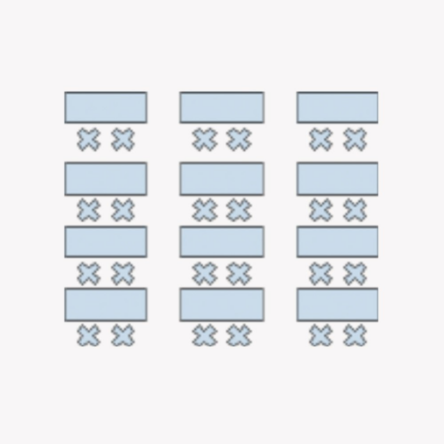
Banquet-Style Seating
This seating arrangement features round tables with chairs placed around them, often used for formal dinners, award ceremonies, or other events that require a more social and interactive atmosphere.

U-Shaped Seating
Tables are arranged in a U-shape, with the open end facing the stage or presentation area. This is often used for panel discussions, workshops, or meetings where attendees need to interact with one another. This seating arrangement also works very well for product presentations and demonstrations and is a popular request in our event space at United Co.
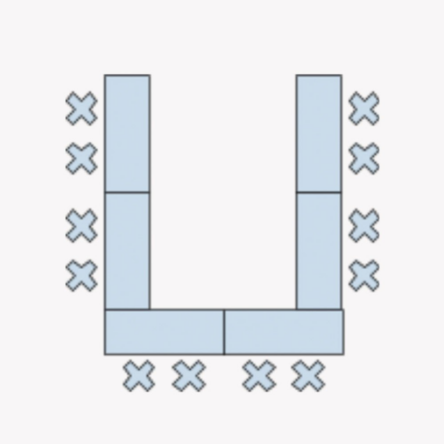
Boardroom-Style Seating
This is a more formal setup, often used for small meetings or executive gatherings. The table is arranged in a rectangle or oval shape with chairs placed around it.
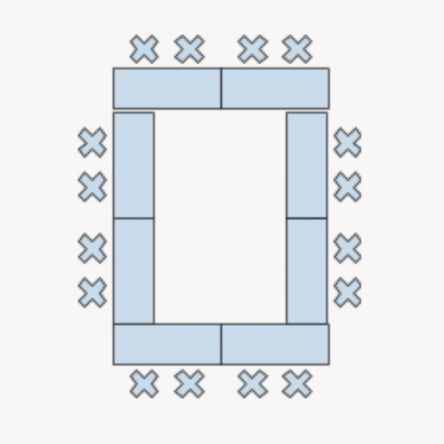
Workshop-Style Seating
This seating arrangement has smaller tables or brainstorming corners, perfect for interactive sessions. You can choose a room set up with beanbags and or ottomans. This will create a more agile and collaborative environment, depending on the objective of the meetings.
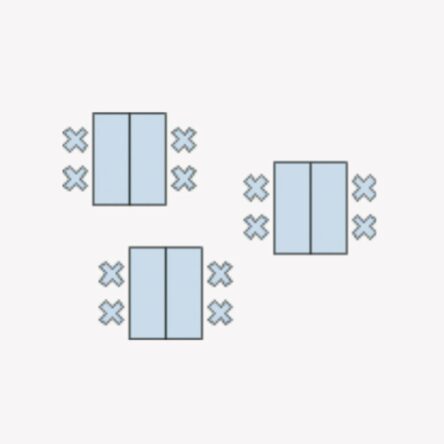
This seating arrangement has smaller tables or brainstorming corners, perfect for interactive sessions. You can choose a room set up with beanbags and or ottomans. This will create a more agile and collaborative environment, depending on the objective of the meetings.
These are just a few examples of the types of seating arrangements that can be used at corporate events. The choice of seating arrangement should be based on the event goals, the number of attendees, and the type of event being held.
Read More About 8 Meeting Room Setup That Foster Productive Collaboration
What is the most effective seating arrangement?
The most effective seating arrangement at a corporate event depends on the specific goals and objectives of the event. There is no one-size-fits-all answer to this question as different events require different setups to achieve their desired outcomes.
For instance, if the main goal of a corporate event is to facilitate networking and interactions among attendees, a cocktail-style reception with small high-top tables and no formal seating could be the most effective setup. This encourages guests to circulate and engage in conversations with multiple people throughout the event space.
On the other hand, if the event is a formal dinner or banquet, a banquet-style seating arrangement with round tables and place settings can be more effective. This setup encourages guests to sit and socialize with those at their table, and the more formal environment can facilitate more in-depth conversations and networking.
For conferences or meetings, a theater-style seating arrangement with rows of chairs facing a stage or presentation area can be effective. This setup allows attendees to focus on the speaker or presenter and provides an unobstructed view of any visual aids or presentations. Ultimately, the most effective seating arrangement for a corporate event is one that aligns with the event’s goals and facilitates interaction and engagement among attendees.
Are seating layouts important at events?
Seating layouts are important at events because they can significantly impact the overall experience of attendees. How seating is arranged can influence the atmosphere, the level of interaction among attendees, and the flow of the event.
For example, if the goal of an event is to facilitate networking and socializing, a seating layout that encourages mingling and conversation, such as cocktail-style seating or banquet-style seating, may be more effective than a theater-style seating arrangement, which can be more formal and less conducive to interaction.
Similarly, the type of seating layout can impact the level of engagement and attention that attendees give to presentations or speeches. A theater-style seating arrangement, with attendees facing the front of the room, may be more effective for events where the focus is on presentations or keynote speeches, whereas classroom-style seating with tables and chairs may be more appropriate for training sessions or workshops.
Seating layouts can also have practical considerations, such as ensuring that attendees have clear lines of sight to the stage and screen or presentation area or accommodating individuals with mobility or accessibility needs.
Overall, seating layouts are an important consideration in event planning, as they can impact the atmosphere, engagement, and overall success of the event.
Read More About How to Drive Business Growth Through Corporate Events
How should you plan your seating arrangement?
Planning a seating arrangement for an event can be a complex process, but some key steps can help you create an effective layout:
1. Define your event goals
The first step is to define the goals and objectives of your event, as this will inform the type of seating arrangement you choose. Consider what type of event you are hosting, the number of attendees, and what you hope to achieve through the event.
2. Choose the right venue
The venue you choose will impact the type of seating arrangement you can have. Consider the size and layout of the space, as well as any restrictions or requirements that may impact the seating layout.
3. Determine the number of attendees
Knowing how many attendees you expect will help you determine the appropriate number of seats and tables required for the event.
4. Consider the type of event
Different types of events will require different seating arrangements. Consider whether your event is a presentation, seminar, banquet, conference, or networking event, and choose a seating arrangement that aligns with the objectives of the event.
5. Create an accessibility plan
Ensure that your seating arrangement is accessible for attendees with mobility or accessibility needs. Consider the location of restrooms, wheelchair accessibility, and whether any obstructions may impede access.
6. Consider the flow of the event
Consider how attendees will move through the space during the event, and how the seating arrangement will impact the flow of traffic. Ensure that there is enough space for attendees to move freely and that the seating arrangement does not create any bottlenecks or blockages.
7. Test the layout
Once you have determined the seating arrangement, test it out by physically setting up the tables and chairs in the venue. This will help you identify any issues with the layout and make adjustments as necessary.
By following these steps, you can plan a seating arrangement that aligns with the objectives of your event and provides a positive experience for attendees.
Read More About 7 Tips To Successfully Running A Corporate Events In Melbourne
How to choose the right event space
Choosing the right event space is crucial to the success of a corporate event. Here are some factors to consider when choosing an event space:
1. Capacity: Ensure that the event space can accommodate the number of attendees you expect. Be sure to consider the size of the space, the seating layout, and any other furniture or equipment that may take up space.
2. Location: Choose a location that is easily accessible to your attendees. Consider factors such as transportation options, parking availability, and proximity to hotels and restaurants.
3. Layout and design: As discussed, determining the layout and design of the event space, and whether it aligns with the objectives of your event is crucial if you want to host a successful and meaningful event. Consider the type of seating arrangement you require for the objective of the event, the availability of audio-visual equipment, and the overall ambiance of the space.
4. Amenities and services: Look for event spaces that offer amenities and services that can enhance the experience of your attendees, such as catering services, audio-visual equipment, and Wi-Fi.
5. Budget: Consider the cost of the event space, and whether it aligns with your budget. Be sure to factor in any additional costs such as catering, equipment rental, and staffing.
6. Reputation: Choose an event space with a good reputation for hosting successful corporate events. Look for online reviews and testimonials from previous clients.
7. Accessibility: Ensure that the event space is accessible for attendees with disabilities or mobility issues. Check for features such as wheelchair ramps, elevators, and accessible restrooms.
By considering these factors, you can choose an event space that aligns with the goals and objectives of your corporate event and provides a positive experience for attendees.
Event space at United Co.
United Co. offers a modern event space in Melbourne with a flexible venue suitable for a variety of corporate events. With a contemporary design, state-of-the-art audio-visual equipment, and an on-site support team, we ensure seamless assistance throughout the day. The space can accommodate up to 120 people seated or 150 standing and can be configured in various seating arrangements to suit your event’s needs. Catering is provided by our in-house licensed café and can be arranged through our dedicated event coordinator.
United Co. provides a unique venue for corporate events that enhances the experience of attendees. Contact the United Co. team today to discuss your next event.
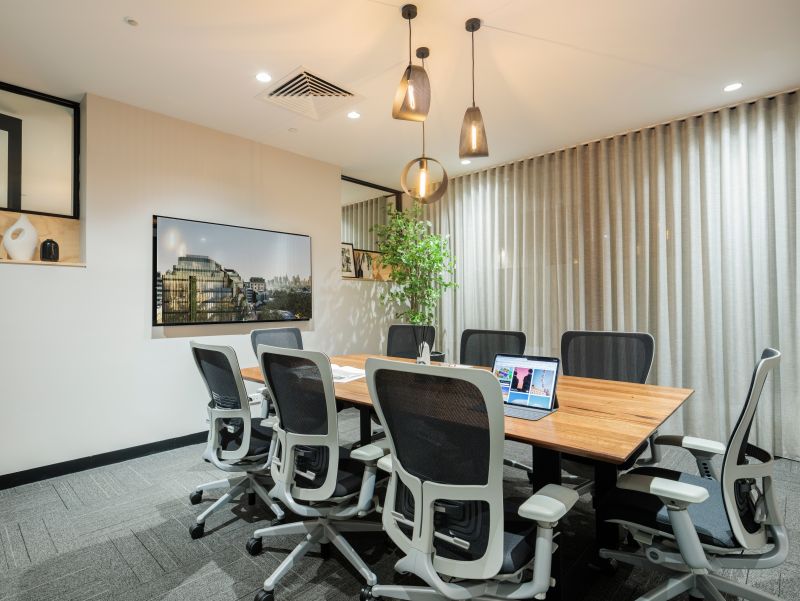
United Co.
425 Smith St. Fitzroy VIC 3065
Melbourne, Australia
Wurundjeri Country

